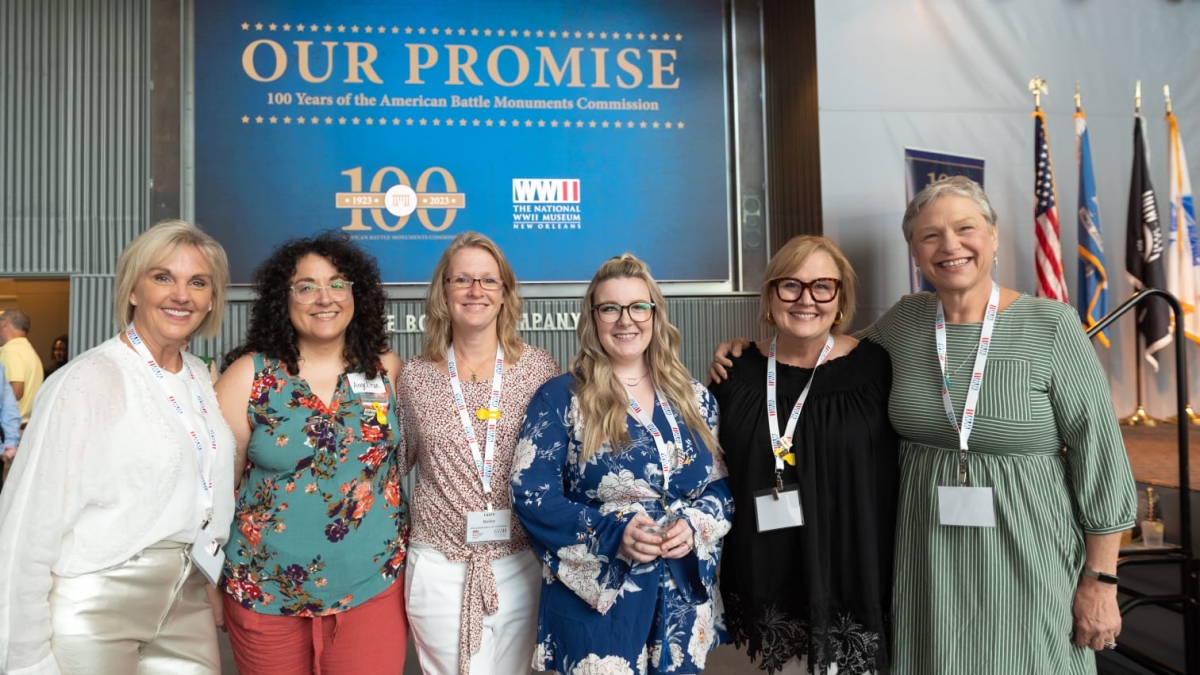World War II studies program inspires friendships, podcast

"The Riveting Rosies" (from left): Julia Gimbel, Angèlica Cordero, Laura Bailey, Carys Caffarel, Robin LaCorte and Mary Ellen Page. Photo courtesy Frank L. Aymami III/www.eye-creative.com
When Robin LaCorte and Laura Bailey met each other for the first time outside The National WWII Museum in New Orleans, the two women had already known each other for years.
“Robin and I clicked in New Orleans,” Bailey said. “We were the first to meet in person, and we sat on a bench outside for hours and we just talked and we cried and it was like we were giddy. All of our backgrounds are so varied, and we bring such different perspectives and interests. It’s a sisterhood. It really is.”
The sisterhood to which Bailey is referring includes her, LaCorte and four other women: Carys Caffarel, Angèlica Cordero, Julia Gimbel and Mary Ellen Page.
All six women are graduates of Arizona State University's World War II studies master’s degree program, which was launched through ASU Online in partnership with The National WWII Museum.
The group has dubbed themselves "The Riveting Rosies," and they recenlty launched a podcast called "World War S.H.E. (Sharing Human Experiences)" and an Instagram account.
The podcast is designed to be a deep-dive discussion on World War II, highlighting women’s roles during the war.
“The angle we’re aiming for is World War II in relation to the women’s perspective,” Caffarel said. “I think that gets left out a lot. Telling the story through that lens is incredibly different, especially focused on war, because when you think of the war, you don’t necessarily think of women.”
Perhaps the most recognizable woman of World War II — and the namesake of the group — is Rosie the Riveter. Her bandana-bound hair and flexed arm with the words “We Can Do It!” emblazoned above her has come to represent the female workforce that stepped up to fill the gaps while the country’s men were at war.
“To me, Rosie is every woman that participated in the war — from little girls that were helping with aluminum can drives to the women who were farmers that were part of the land army,” Cordero said. “It’s the women who were stenographers. It’s all of them.”
Each Riveting Rosie has niche interests to bring to the podcast — from Holocaust survivorship to World War II-era slang.
Of the six podcast hosts, Page is self-admittedly the most battle-minded of the group.
“I love reading about specific battles, about troop movements,” Page said. “I love supply, logistics and that kind of thing. What I want to do is tell the stories of those battles, but use women to do it. The Battle of Stalingrad had a million Red Army soldiers who were fighting, who were women. They were pilots, they were snipers. But also you had mothers and children in the city. You could tell the entire story of the battle through their eyes, and you would still get what you needed historically.”
By contrast, Gimbel prefers to focus on the softer side of history.
“I'm more of a social historian than a military historian,” Gimbel said. “I’m interested in the people's stories and how the war impacted their personal lives.”
Launching a history podcast with six hosts provided its own set of challenges, the least of which was scheduling.
“Six people in a Zoom — it’s a lot,” LaCorte said. “It’s half party, half business.”
Nevertheless, the women are confident that they can provide something that doesn’t yet exist in the World War II podcast realm.
“There’s six master’s degree-holders on this thing,” Cordero said. “Six! I don’t know any podcast that has more than two. There’s something to be said knowing that there’s the power of six master’s degrees behind this.”
Each Rosie connected during the World War II studies program the same way: searching for help during a group project.
“I remember in the first class, we had a group project,” Caffarel said. “And I thought to myself, ‘This is ridiculous. This is a master’s program! We shouldn’t be doing group projects.’ But this group project forced me to connect with Laura. We ended up chatting after the program and it just sort of snowballed.”
“Carys and I are the ones that met first,” Bailey said. “She and I started texting and helping each other out with various questions and bouncing ideas off each other. And then we met Mary and then Robin and Angèlica and then Julia.”
The group friendship flourished across cohorts and the country, until this past June when The National WWII Museum honored the program’s graduates with a ceremony celebrating their dedication to preserving WWII history.
For the first time, all the Rosies were in the same room.
“That was the first time all six of us were ever together at the same time,” Page said. “That was probably one of my favorite weekends of my life. It was just so fabulous finally all being together.”
Cordero agrees.
“Everybody should just go to an online degree program and get the best friends for the rest of your life that you never knew existed,” she said.
More Arts, humanities and education

ASU+GSV Summit brings experts together to discuss advancements in education
Arizona State University President Michael Crow kicked off the ASU+GSV education technology summit in San Diego on Monday with a…

ASU professor's project helps students learn complex topics
One of Arizona State University’s top professors is using her signature research project to improve how college students learn…

Award-winning playwright shares her scriptwriting process with ASU students
Actions speak louder than words. That’s why award-winning playwright Y York is workshopping her latest play, "Becoming…

